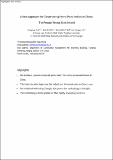| dc.contributor.author | Zheng, Siqi | |
| dc.contributor.author | Liu, Hongyu | |
| dc.contributor.author | Guo, Xiaoyang | |
| dc.contributor.author | Geltner, David M | |
| dc.date.accessioned | 2017-09-06T16:05:59Z | |
| dc.date.available | 2017-09-06T16:05:59Z | |
| dc.date.issued | 2014-01 | |
| dc.date.submitted | 2013-01 | |
| dc.identifier.issn | 1051-1377 | |
| dc.identifier.issn | 1096-0791 | |
| dc.identifier.uri | http://hdl.handle.net/1721.1/111137 | |
| dc.description.abstract | This paper develops a “pseudo repeat sale” estimation sample construction procedure (ps-RS) to construct more reliable and less biased quality-controlled price indices for newly-constructed homes. The method may be useful wherever new housing development is of sufficiently large scale and homogeneous. Such circumstances characterize many emerging market countries, and here we apply the technique in China. We match two very similar new sales within a defined matching space. Here we test three versions of matching spaces – complex, phase, and building. We then regress the within-pair price differentials onto time dummies and the differentials in unit-specific physical attributes. Locational and community variations, as well as many unobservable or difficult to measure physical attribute variations, are cancelled out in the model, and thereby controlled for. The building-version ps-RS index does the best job in this regard because its within-pair differential is the smallest. We further introduce a “hedonic value” distance metric criterion so that one can deal flexibly with the trade-off between the within-pair “similarity” and the sample size. We explicate and demonstrate formal signal-to-noise oriented metrics of index quality, which can be superior to traditional standard errors based metrics, and we use the new metrics to compare index construction methodologies. The ps-RS approach addresses the problem of lack of repeat-sales data in emerging markets and newly constructed properties and the omitted variables problem in the hedonic method. It also addresses the traditional problems with the classical same-property repeat-sales model in terms of small sample sizes and sample selection bias.
The present paper tests the ps-RS method using a large-scale micro transaction data set of new home sales from January 2006 to June 2011 (444,596 observations) in Chengdu, Sichuan Province, China. The resulting complex-based ps-RS index essentially parallels the hedonic index, suggesting that the hedonic index is not superior to that version of the ps-RS index in terms of systematic results. The phase-based ps-RS index has a lower growth trend and the building-based version lower still, indicating omitted variables relating to the physical quality of the units are not well controlled for in the hedonic, and suggesting that the building-based version of the ps-RS index provides the greatest control for such quality differences. Building-based ps-RS indices with different distance metric thresholds are almost the same. Compared to the hedonic, the ps-RS provides a smoother index indicating less random estimation error (or “noise”). | en_US |
| dc.language.iso | en_US | |
| dc.publisher | Elsevier | en_US |
| dc.relation.isversionof | http://dx.doi.org/10.1016/j.jhe.2014.01.005 | en_US |
| dc.rights | Creative Commons Attribution-NonCommercial-NoDerivs License | en_US |
| dc.rights.uri | http://creativecommons.org/licenses/by-nc-nd/4.0/ | en_US |
| dc.source | MIT Web Domain | en_US |
| dc.title | A new approach for constructing home price indices: The pseudo repeat sales model and its application in China | en_US |
| dc.title.alternative | A new approach for constructing home price indices: The pseudo repeat sales model and its application in China | en_US |
| dc.type | Article | en_US |
| dc.identifier.citation | Guo, Xiaoyang et al. “A New Approach for Constructing Home Price Indices: The Pseudo Repeat Sales Model and Its Application in China.” Journal of Housing Economics 25 (September 2014): 20–38. | en_US |
| dc.contributor.department | Massachusetts Institute of Technology. Department of Urban Studies and Planning | en_US |
| dc.contributor.mitauthor | Guo, Xiaoyang | |
| dc.contributor.mitauthor | Geltner, David M | |
| dc.relation.journal | Journal of Housing Economics | en_US |
| dc.eprint.version | Original manuscript | en_US |
| dc.type.uri | http://purl.org/eprint/type/JournalArticle | en_US |
| eprint.status | http://purl.org/eprint/status/NonPeerReviewed | en_US |
| dspace.orderedauthors | Guo, Xiaoyang; Zheng, Siqi; Geltner, David; Liu, Hongyu | en_US |
| dspace.embargo.terms | N | en_US |
| dc.identifier.orcid | https://orcid.org/0000-0002-1024-7555 | |
| mit.license | PUBLISHER_CC | en_US |
| mit.metadata.status | Complete | |
